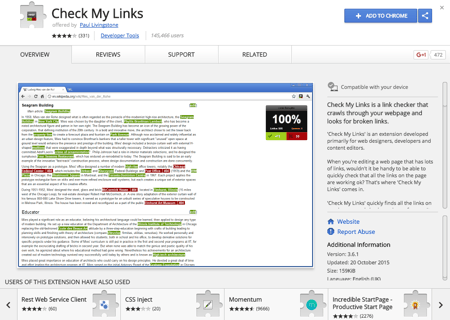
4 Out-of-the-Box Ways to Get Inbound Links
May 3, 2017

Ah—inbound links. Valuable. Coveted. Necessary. Not only do they provide validation that your content is good (even if it is internal validation), but inbound links also provide a signal to Google that your site is authoritative, which makes your SEO rankings soar.
No wonder there are entire corners of the web dedicated to getting inbound links (also known as “backlinks”) to your site. Here are four out-of-the-box ways you can get going on this valuable tactic:
#1: Create content that practically screams “link to me”
The easiest way to get inbound links is to create content that people love to share. No extra work required!
Round-ups, lists of resources, and other in-depth curation of data frequently fit the bill. Round-ups that feature other companies will naturally lend themselves to that company linking to the post. Resource lists similarly draw attention to the companies you feature. Other easily shareable ideas are outlined in this great post on our blog from last January, “9 Different Blog Post Types and How to Use Them.”
While a primary goal of an expert interview series on your blog might be drawing an audience, a secondary goal might be getting each expert to link to his or her interview from your site (and promote on social media!).
Neil Patel recommends creating content around original research in his blog post “5 Ways to Amplify the Reach of Your Content Without Spending a Dime.” He says: “After all, the first step to amplifying your reach is to create content people are genuinely interested in.  This is a natural catalyst for shares and links. One type of content in particular that kills it is content that includes original research. By this I mean statistics, graphs, charts, and other forms of data that provide readers with in-depth insight on a topic.”
This is a natural catalyst for shares and links. One type of content in particular that kills it is content that includes original research. By this I mean statistics, graphs, charts, and other forms of data that provide readers with in-depth insight on a topic.”
Another type of content that people love to share and link to is anything funny or outrageous. Take, for example, the proliferation of April Fools’ Day business jokes and the ensuing round-up posts such as AdWeek’s “April Fools’ Day 2017: Our Roundup of All the Best Brand Hoaxes.” Do something funny—people will link to you. Inbound-link gold!
#2: Provide value and ask for a link in return
Emailing someone out of the blue and asking for a link will get you a-whole-lotta-nowhere-fast. Enough spammers/black-hat SEO enthusiasts have gone this route, and people just tune them out.
So how do you get someone’s attention? By giving them something of value. Everyone likes getting help, and if you do a good job, he or she might be open to a small request.
“The Most Creative Link Building Post Ever” by Jon Cooper at PointBlankSEO details some of the most creative tactics that professionals have used to get an inbound link. One story talks about trading an inbound link for the creation of a new blog header (which was then sourced from Fiverr). Using that same idea in the B2B realm might evolve to participating on a panel with one of your partners or providing a reference for a software company you do business with in exchange for a link.
Links from .edu domains are the creme de la creme for link-building marketers. This is because Google sees .edu websites as having high domain authority. Some ideas to get these coveted links by trading something of value:
- Offer to give a guest lecture to a business class and have the syllabus link to your website.
- If you have some funds, set up a scholarship and promote it through the school.
- Help the local business club put together an event or a new website.
- More ideas by Neil Patel in his post: “8 Unusual Link Building Strategies That’ll Catapult Your Rankings.”
Another version of this method is outlined by Brian Dean in his excellent blog post “17 Untapped Backlink Sources.” You start by Googling resource lists in your target market such as “dog sitting” + “resource page” or “dog sitting” + “recommended websites.” Once you’ve found a few websites that list sites (such as yours) that you want to target, go to Step 2.
 From Brian: “Now you COULD email them and just ask for a link. But I’ve found that begging doesn’t work very well. Instead, give the site owner a hand by letting him know about any broken links that you happen to find. You can easily find the broken links on any page. Just use the nifty Chrome Extension Check My Links.”
From Brian: “Now you COULD email them and just ask for a link. But I’ve found that begging doesn’t work very well. Instead, give the site owner a hand by letting him know about any broken links that you happen to find. You can easily find the broken links on any page. Just use the nifty Chrome Extension Check My Links.”
Once you have a list of broken links on the resource page, write a nice email to the webmaster, letting him or her know about the broken links (with a list of the ones you found) and conclude with something friendly such as Brian’s recommendation: “Oh, and I have a website, mysite.com, that also regularly posts quality content related to whatever. If you think so too, feel free to post a link to it on your resources page. Either way I hope this helps and keep up the good work!”
#3: Write, write, and write
Inbound marketers are looking for content. They know that content drives their machine and will take all they can get. So what does that mean for you, the inbound-link-craving enthusiast? You can be the one to provide that content (and earn a backlink in return)!
One form this might take is finding opportunities to guest post on other blogs related to your industry. You could do a Google search for “topic” + “guest post” or ask customers/leads/colleagues what blogs they frequently read in your topic arena. Then reach out and pitch your idea!
If you have some more free time to invest, another methodology suggested in “101 Ways to Get Quality Backlinks To Your Blog in 2017” by ShoutMELoud is to find broken links on high-quality sites related to your industry. Depending on the link and topic, you may already have content that fits perfectly, or you may have to create something from scratch. Then email the website owner, let him or her know the link is broken and that you just so happen to have an article that might work as a replacement!
#4: Invest in PR
Not sure how “out of the box” this suggestion is, but it’s an extremely powerful way to get high-quality inbound links to your website—and that is through public relations.
On the informal side, articles such as “Inbound Link Building 101: 33 White Hat Ways to Build Backlinks for SEO” by Corey Northcutt at HubSpot suggest HARO (Help A Reporter Out), which sends out alerts when reporters are looking for sources to quote on a variety of topics. If you are timely and relevant, you could be quoted in publications ranging from the obscure to the behemoth (and get a link to your website).
However, partnering with a strategic PR firm will get inbound-link-minded marketers much further along on their journey. A quality PR firm can get your company mentioned in more high-quality publications faster than you can. Trust me.
Bonus (easy) tip: Ask people who mention your company to add a link
This suggestion also comes from Brian Dean. Simply set up a Google Alert (or other service) to notify you when someone mentions your company. Then when you get an alert, check and see if a link to your website is included. If not, jet the author an email and ask if he or she will add one!
--
Inbound links can skyrocket your inbound marketing and traffic generation efforts. Do you have any other out-of-the-box ways through which you’ve gotten backlinks? Share in the comments!

About the author
Jessica Vionas-Singer was formerly the Senior Director of Client Success at SmartBug Media where she lead a team of SmartBugs who focus on HubSpot onboarding for clients new to the system and other project-based work, oversaw new employee onboarding, and rolled out new process and procedures within the Client Services department. She fell in love with marketing at her first job at a technology company specializing in credit evaluation software. Her background includes more than 20 years of marketing experience in content creation and lead-driving tactics, online presence and blog creation, social media engagement, budgeting and project plans, webinar and trade show event management, public relations, comprehensive promotional campaigns, and analytics. Jessica has a BS in Sociology from Montana State University – Bozeman. Read more articles by Jessica Vionas-Singer.








